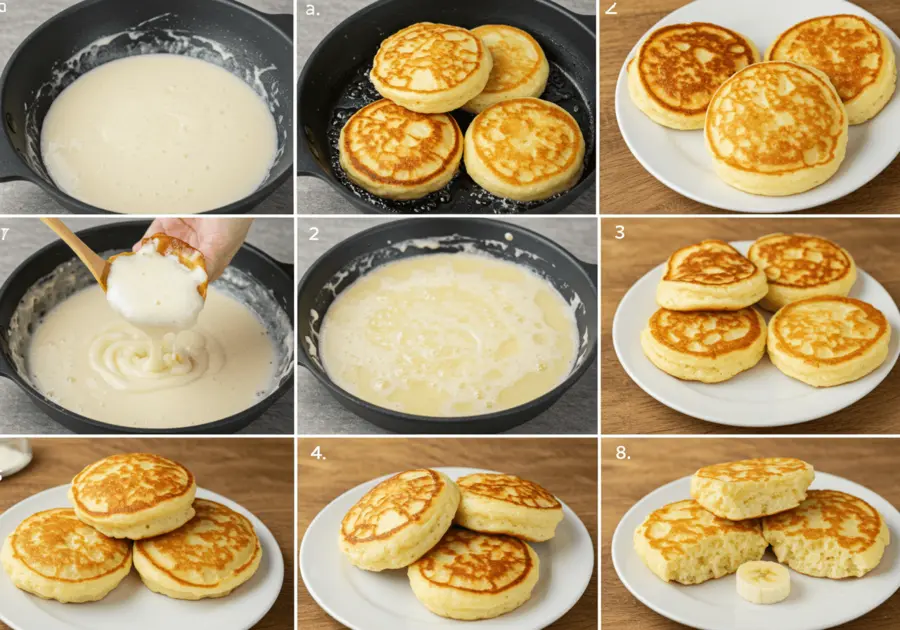
Take your breakfast to the next level with Filipino pancakes, or “pancakes pinoy.” This guide will show you how to make these beloved pancakes at home. You’ll learn the secrets to their fluffy texture, vibrant colors, and irresistible taste.
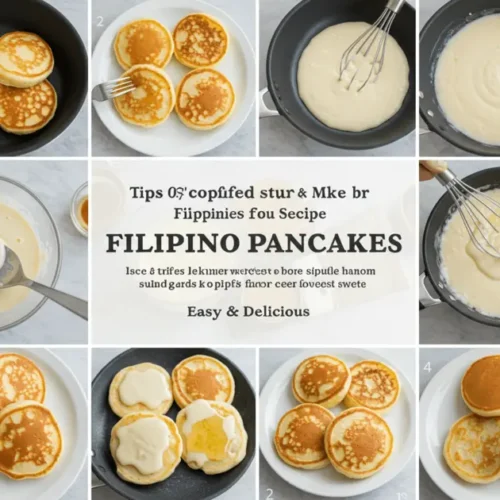
Pancakes Pinoy
Ingredients
- 1 cup all-purpose flour
- 1/2 cup rice flour
- 1/4 cup coconut flour
- 1/2 cup brown sugar or muscovado sugar
- 1 tsp baking powder
- 1/2 cup coconut milk
- 2 large eggs
- 1 tsp pandan extract (optional)
- Pinch of salt
- Butter or oil for frying
Instructions
- In a large bowl, combine all-purpose flour, rice flour, coconut flour, baking powder, and brown sugar.In another bowl, whisk together coconut milk, eggs, and pandan extract (if using).Slowly add the wet ingredients to the dry ingredients, stirring gently until just combined. The batter should be slightly lumpy.Heat a non-stick pan or griddle over medium heat and lightly grease it with butter or oil.Pour about 1/4 cup of batter onto the griddle for each pancake. Cook until bubbles form on the surface, then flip and cook until golden brown on both sides (about 2-3 minutes per side).Serve hot with your favorite toppings such as coconut syrup, condensed milk, or fresh tropical fruits.
Table of Contents

Key Takeaways
- Explore the origins and cultural significance of traditional Filipino pancakes
- Learn the essential ingredients and kitchen tools needed for authentic pancakes pinoy
- Master the step-by-step mixing instructions for fluffy and light pancakes
- Discover secret tips and techniques to achieve the perfect pancake texture
- Indulge in popular Filipino pancake variations and delectable topping ideas
Introduction to Traditional Filipino Pancakes
Pancakes are a big part of Filipino breakfasts, with a history that goes back centuries. These special pancakes, known as “pandesal”, have become a key part of Filipino food.
FiliPinoy’s crispy and fluffy Pancake or Omelet have s history dating back to the Spanish colonization of the The Philippines when the newly discovered archipelago was being traded with Europe. As the Spaniards introduced advanced baking techniques, a blend of Filipino culinary culture mixed with the newly imported methods to create a pancake garnished with coconut milk, sticky rice and purple sweet potatoes.
It is also important to note the fact that while ordinary pancakes are one-dimensional in taste; salty ingredients, brown sugar, coconut milk and palm sugar allows one to truly appreciate the deep flavor profile Filipino pancakes have to offer. Not only are FiliPinoy’s pancakes love by tourists but also truly exceptional in their texture. The Philippines’s unique use of sticky rice flour, allows the pancake to be both chewy and soft.
As you travel around The Philippines, you are bound to meet regional variation of the pancake, something every native from The Philippines takes pride in. The pandesal, or what we Filipinos like to call the healthy pancake, is the ultimate example of the melting pot of flavors and global influences The Philippines has to offer.
With noodles soup and savory rice alongside it, pandesal make up the traditional breakfast of the average Filipino. As you savor the healthy pancake, it is impertative to understand the culture and rich history that surrounds it.
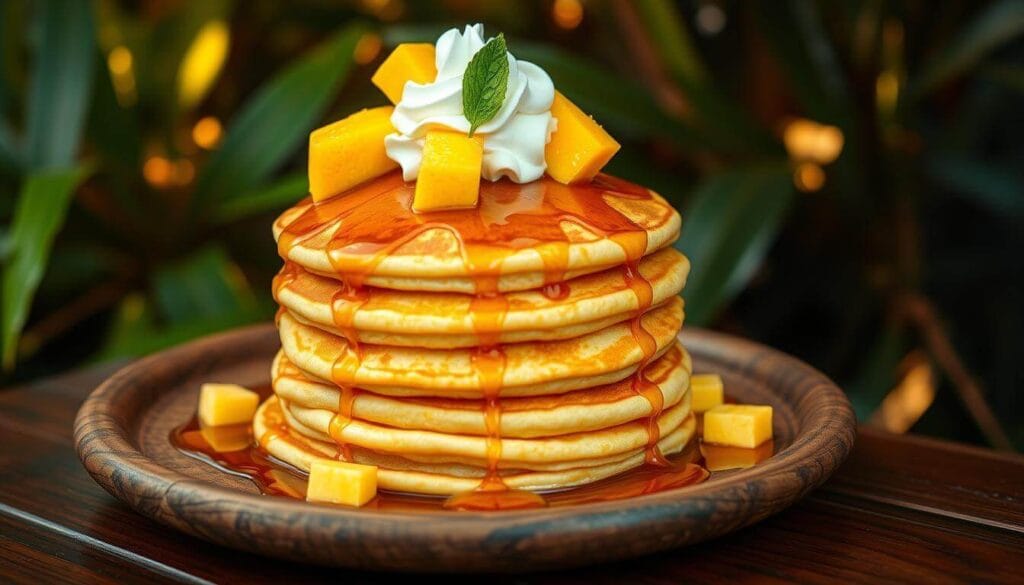
Essential Ingredients for Authentic Pancakes Pinoy Recipe
Making delicious Filipino-style pancakes needs the right ingredients. These include flour, sweeteners, and flavorings. Each one is key to getting the taste and texture just right.
Flour Power: The Foundation of Pancakes Pinoy
The base of a true Filipino pancake is the flour. You can use all-purpose flour, but many recipes mix in rice flour and coconut flour. This mix gives the pancakes a chewy texture and a hint of coconut.
Sweeteners: Enhancing the Pinoy Flavor Profile
Brown sugar or muscovado sugar are must-haves for Filipino pancakes. They add a rich, caramel-like taste. For more sweetness, try adding coconut syrup or pandan extract.
Flavorful Finishes: Aromatic Additions
To really get the Filipino pancake taste, use coconut milk and pandan leaves. Coconut milk adds a creamy, tropical flavor. Pandan leaves give a sweet, vanilla-like scent that’s very Pinoy.
Choosing and mixing these ingredients right will help you make authentic and delicious Filipino pancakes. They’ll taste amazing and take you straight to the Philippines.
| Ingredient | Purpose |
|---|---|
| Rice Flour | Provides a chewy texture |
| Coconut Flour | Adds a subtle coconut aroma |
| Brown Sugar | Imparts a caramelized, molasses-like flavor |
| Coconut Milk | Lends a creamy richness and tropical note |
| Pandan Leaves | Infuse a fragrant, vanilla-like aroma |
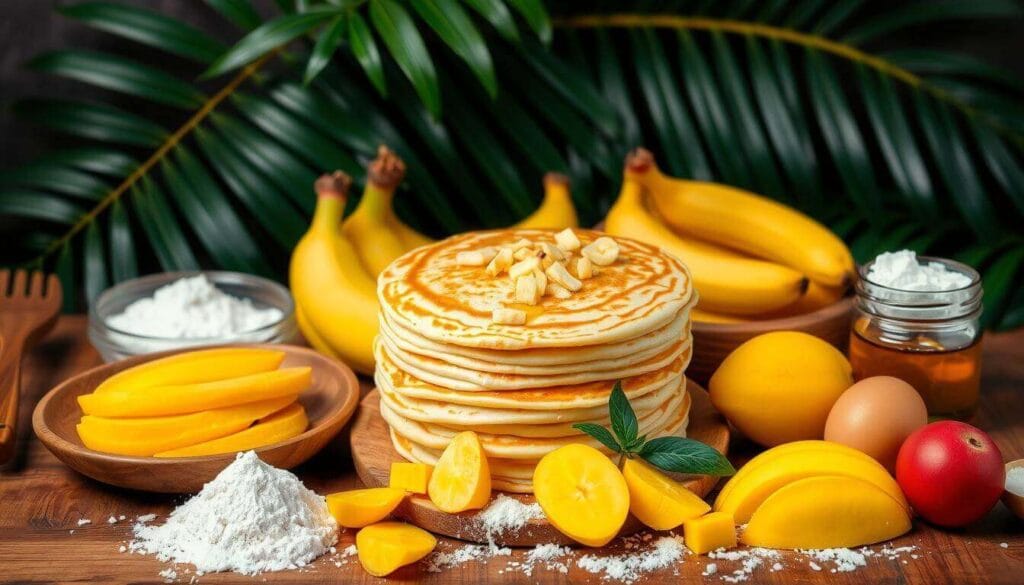
“The secret to the perfect Filipino pancake lies in the harmonious blend of traditional ingredients that capture the essence of Pinoy cuisine.”
Kitchen Tools and Equipment You’ll Need
To make delicious Filipino pancakes, you need some key tools. You’ll need a good pancake griddle, mixing bowls, and a kitchen scale. The right tools make a big difference in making pancakes.
Basic Utensils for Perfect Flipping
Flipping pancakes right is key to their taste and look. Use a strong non-stick pan or a pancake griddle for easy flipping. A thin, flexible spatula is also essential for smooth flipping.
Recommended Cookware Options
- Nonstick skillet or griddle: Choose a pan with a smooth surface for even heating.
- Flexible silicone or metal spatula: A thin, wide spatula helps in easy pancake flipping.
- Whisk: A good whisk makes your batter smooth and lump-free.
Measuring Tools for Accuracy
Accurate measurements are crucial for tasty pancakes. You’ll need measuring cups and spoons for this. Also, a kitchen scale helps in weighing ingredients for the best results.
| Tool | Purpose |
|---|---|
| Measuring cups | Measure dry and liquid ingredients accurately |
| Measuring spoons | Measure small amounts of spices, baking soda, and other ingredients |
| Kitchen scale | Weigh ingredients for precise measurements |
With the right tools, you’ll make perfect Filipino pancakes every time.
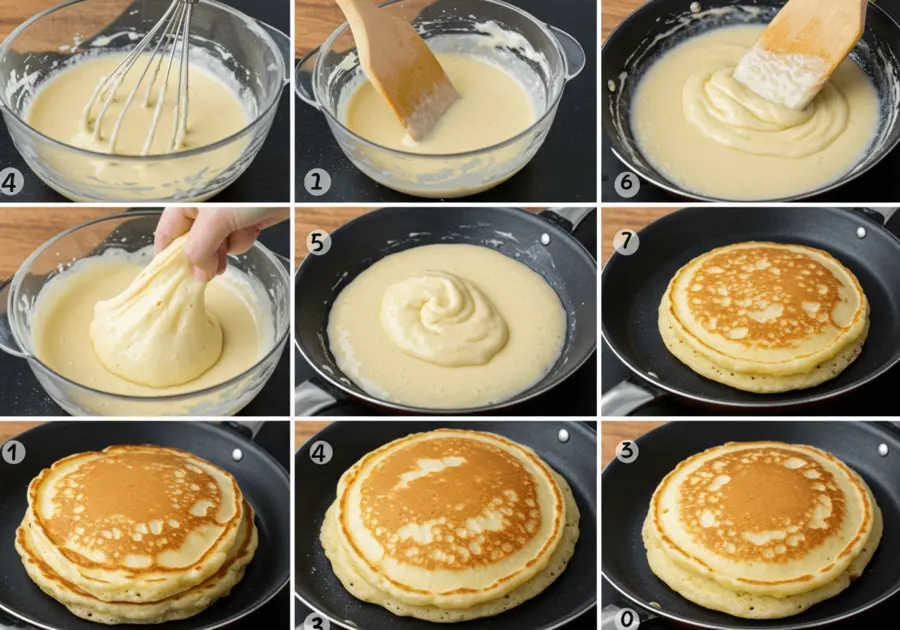
Step-by-Step Mixing Instructions
Learning how to mix the perfect pancake batter consistency is crucial. It’s the secret to making fluffy, tasty Filipino-style pancakes. Whether you’re making traditional pancakes or trying egg-free and vegan Filipino pancakes, the mixing steps are the same. Here’s how to get the batter just right every time:
- First, collect all your dry ingredients: flour, sugar, baking powder, and any spices or flavorings you like. Mix them well in a big bowl to spread them evenly.
- Next, mix the wet ingredients in another bowl: milk (or a non-dairy milk for vegan pancakes), melted butter or oil, and any eggs (or egg replacers for egg-free pancakes).
- Slowly add the wet ingredients to the dry ingredients. Be gentle to avoid overmixing. The batter should still be a bit lumpy and easy to pour.
- If the batter seems too thick, add a bit more milk or non-dairy milk. This will help it reach the right consistency for pancakes.
- For egg-free or vegan Filipino pancakes, you might need to adjust the liquid-to-dry ratio. Eggs help with texture, so you might need more liquid without them.
By following these easy steps, you’ll make pancakes that are light, fluffy, and full of flavor. They’ll truly capture the spirit of Filipino cuisine.
Secret Tips for Fluffy and Light Texture
Making perfect fluffy and light pancakes at home is simpler than you think. A few easy techniques can make your pancakes taste like they’re from a restaurant. Here are the secret tips to make your pancakes a hit with your family and friends.
Temperature Control Techniques
Getting the right temperature is key for light and airy pancakes. Make sure your griddle or pan is at 350-375°F (175-190°C). This ensures the batter cooks evenly without burning the outside before the inside is done.
Mixing Methods for Best Results
- Don’t overmix the batter. Just fold the ingredients together until they’re just combined, leaving a few lumps.
- Beat the egg whites until stiff, then fold them into the batter. This adds air for a light pancake texture.
- Let the batter rest for 15-30 minutes before cooking. This makes the pancakes more tender.
Common Mistakes to Avoid
- Avoid overmixing the batter to prevent tough, dense pancakes.
- Make sure your pan or griddle is hot enough to avoid soggy, undercooked pancakes.
- Don’t flip the pancakes too often. This can make them lose their fluffy texture.
By using these secret tips, you’ll soon be making light, fluffy, and perfectly textured pancakes every time. Enjoy your homemade Filipino-style breakfast treats!
Popular Filipino Pancake Variations
The Philippines has a wide range of pancake flavors. You can try ube pancakes, banana pancakes, and calamansi pancakes. These unique pancakes add excitement to breakfast.
Ube Pancakes: A Vibrant Purple Delight
Ube, a purple yam, makes ube pancakes stand out. It adds a beautiful purple color and a sweet, nutty taste. Enjoy them with maple syrup or other toppings.
Banana Pancakes: A Tropical Twist
Banana pancakes use ripe bananas for their sweetness. They are moist and full of tropical flavors. Add cinnamon or nutmeg for an extra treat.
Calamansi Pancakes: A Citrus Delight
Calamansi pancakes bring a tangy twist. They use the zest and juice of calamansi, a Filipino citrus. This makes the pancakes bright and refreshing.
| Pancake Variation | Key Ingredients | Flavor Profile |
|---|---|---|
| Ube Pancakes | Ube puree or extract, flour, eggs, milk | Vibrant purple color, nutty, sweet |
| Banana Pancakes | Ripe bananas, flour, eggs, milk | Naturally sweet, moist, tropical |
| Calamansi Pancakes | Calamansi zest and juice, flour, eggs, milk | Tart, tangy, refreshing |
Try ube pancakes for a vibrant taste, banana pancakes for tropical sweetness, or calamansi pancakes for a tangy kick. These Filipino pancakes are a great way to start your day with a taste of the Philippines.
Best Toppings and Serving Suggestions
Make your Filipino pancake experience even better with a variety of toppings and serving ideas. You can choose from classic favorites or try new fusion ideas. These options let you enhance the taste and texture of these beloved breakfast treats.
Traditional Filipino Toppings
Try the authentic flavors of the Philippines with classic toppings. Use fragrant coconut syrup for a sweet touch. For creaminess, add a dollop of condensed milk, a favorite in many Filipino desserts.
For a burst of tropical flavor, try mango compote. This vibrant fruit preserve pairs well with the fluffy pancakes.
Modern Fusion Ideas
Go beyond traditional toppings and try new fusion ideas. Add a scoop of ice cream with local fruits like mangoes or bananas. Sprinkle toasted coconut flakes for a nice crunch.
For a fancy touch, drizzle caramel or chocolate sauce on top. The world of pancake toppings is vast, and you can always find something new to try.
| Traditional Topping | Description | Flavor Profile |
|---|---|---|
| Coconut Syrup | A sweet and fragrant syrup derived from the sap of coconut palm trees. | Tropical, lightly sweet, with a hint of coconut. |
| Condensed Milk | A creamy, sweetened dairy product made by removing water from milk. | Rich, creamy, and indulgent. |
| Mango Compote | A vibrant, tangy fruit preserve made from ripe mangoes. | Bright, tropical, and subtly sweet. |
Enjoying Pancakes Pinoy is all about exploring different flavors and textures. Try different toppings and find the perfect mix of sweet and indulgent for you.
Storage and Reheating Guidelines
Keeping your homemade Pancakes Pinoy fresh is easy. Whether you have leftover pancakes or want to save some for later, these tips will help. Your pancakes will stay tasty and soft, just like when they were first made.
Storing Leftover Pancakes
Let leftover pancakes cool down before storing them. Put them in an airtight container or plastic bag. Store them in the fridge for up to 5 days or freeze for longer.
When freezing, use parchment or wax paper between pancakes. This stops them from sticking together.
Batch Freezing Pancakes
You can also freeze pancakes in big batches. Cook and cool the pancakes, then stack them with parchment paper in between. Put the stack in a freezer-safe bag or container and freeze for up to 3 months.
Reheating Frozen Pancakes
To reheat pancakes, thaw them at room temperature for 30 minutes to an hour. Or, reheat them straight from frozen in the toaster, oven, or microwave.
In the oven, place pancakes on a baking sheet and heat at 350°F (175°C) for 5-10 minutes, flipping halfway. In the microwave, heat in 30-second intervals until warm.
By using these simple tips, you can enjoy your homemade Pancakes Pinoy anytime. They’ll stay fresh and delicious.
Troubleshooting Common Pancake Problems
Even the best pancake makers face unexpected challenges. But, with a bit of troubleshooting, you can fix any issue. This way, you’ll make perfect Pancakes Pinoy every time. Let’s look at some common problems and how to solve them for a delicious pancake experience.
Fixing Batter Consistency Issues
If your batter is too thick or thin, there’s an easy fix. For a thick batter, add a splash of milk or water and whisk gently. If it’s too thin, add a bit more flour, mixing well after each tablespoon.
Achieving the Perfect Color
The perfect Pancakes Pinoy is golden-brown. If they’re too pale, try cooking them at a slightly higher temperature. If they’re browning too fast, lower the heat to cook the center without burning the outside.
Temperature Adjustment Tips
Getting the right cooking temperature is key for perfect pancakes. If they’re cooking unevenly, adjust the heat in small steps. Every stovetop and pan is different, so you might need to experiment to find the perfect temperature.
FAQ
What are the main ingredients used in traditional Filipino pancakes?
Traditional Filipino pancakes, or “pancakes pinoy,” use all-purpose flour, coconut milk, and white sugar. They also include eggs and a pinch of salt. Some recipes add rice flour or pandan extract for extra flavor and texture.
How do Pancakes Pinoy differ from Western-style pancakes?
Filipino pancakes are lighter and fluffier than Western pancakes. They have a unique taste from coconut milk and sometimes pandan. The batter has less sugar, letting the natural sweetness of the ingredients stand out.
What are some popular variations of Pancakes Pinoy?
Popular Filipino pancake variations include ube, banana, and calamansi pancakes. These add unique Filipino flavors to the classic pancake recipe.
What are the best toppings and serving suggestions for Pancakes Pinoy?
Traditional toppings are coconut syrup, condensed milk, and margarine or butter. Try fresh tropical fruits like mangoes, papayas, or pineapples for a modern twist. Enjoy with hot chocolate or strong coffee too.
How should I store and reheat leftover Pancakes Pinoy?
Store leftover pancakes in an airtight container in the fridge for 3-4 days. Reheat on a greased skillet or griddle over medium heat, flipping often. Or, reheat in a 350°F oven for 5-10 minutes.
What are some common mistakes to avoid when making Pancakes Pinoy?
Avoid over-mixing the batter and using the wrong cooking temperature. Don’t forget to let the batter rest before cooking. Proper heat control and batter consistency are crucial for a fluffy texture.
Choose what you like from the breakfast menu to start your day happily
what did you think about this recipe?
There are no reviews yet. Be the first one to write one.